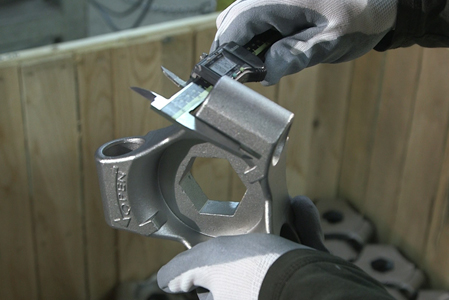RADII
The general tolerance should be +/- 1/64″. In rare cases, where closer tolerances are required, the best that can be held is +/- .005″ for radii under 1″.
ANGLES
The angular tolerance on an investment casting should not be closer than +/- 2 degrees.

ROUNDNESS
Diametrical variations in solid round sections can be seen in the table below:
ROUNDNESS TOLERANCE T I R DIAMETER .010″ 1/2″ .016″ 1″ .024″ 1 1/2″ If larger tubular castings are made, closer diameter tolerances can be held through mechanical straightening. It should be noted that wall thickness should be small enough to allow corrective action. In such cases, the following table can be used:
ROUNDNESS FINISHED T I R OUTSIDE DIAMETER .006 1/2″ .008 1″ .010 1 1/2″ .015 2″ CONCENTRICITY
The following table shows the amount of eccentricity in a typical investment casting. Generally, the heavier the wall and smaller the 2 diameters, the more difficult it is to straighten the part mechanically.
OUTSIDE DIAMETER INSIDE DIAMETER T I R ECCENTRICITY 3/4″ 1/4″ .008″ 1″ 1/2″ .010″ 1 1/2″ 3/4″ .010″ 2″ 1″ .016″
HOLE TOLERANCE
Best tolerances for holes are as follows:
- up to .250″ diameter: +/- .003″
- up to .500″ diameter: +/- .004″
- over .500″ diameter: +/- .005″ per inch.
These tolerances apply to round holes, D-holes and square holes. Tolerances on hole centers should conform to the limits defined in the RECOMMENDED TOLERANCES table.
Flatness and straightness are very closely related. If high degree of flatness and straightness is required, castings have to be mechanically straightened or machined. Proper design can control distortion and minimize straightening operations.
It should be remembered that flatness and straightness tolerances deal with bow only and should not be confused with surface irregularity such as sinks produced by bosses, etc.
Tolerances for flatness and straightness are .003″ to .005″ T I R per linear inch and depend on alloy and configuration of casting.
RECOMMENDED TOLERANCES
For all functional dimensions the linear tolerance chart should be used. For non-functinal dimensions, wider casting tolerances will result in a more economical design.
INCHES MILLIMETERS DIMENSIONS TOLERANCE DIMENSIONS TOLERANCE up to 1″ +/-.010 up to 25mm +/-0.25mm up to 2″ +/-.013 up to 51mm +/-0.33mm up to 3″ +/-.016 up to 76mm +/-0.41mm up to 4″ +/-.019 up to102mm +/-0.48mm up to 5″ +/-.022 up to 127mm +/-0.56mm up to 6″ +/-.025 up to 152mm +/-0.64mm up to 7″ +/-.028 up to 178mm +/-0.71mm up to 8″ +/-.031 up to 203mm +/-0.79mm up to 9″ +/-.034 up to 229mm +/-0.86mm up to 10″ +/-.037 up to 254mm +/-0.94mm Over 10 inches allow +/- 0.005″ per additional inch. Over 254mm allow +/- 0.13mm for each additional 25mm

